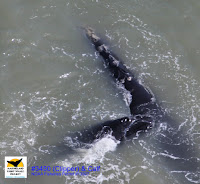It was a long wait to see our first right whales and, thankfully, they stayed around several days, giving us multiple opportunities. The first came on Friday, 29 January. Julie Albert of Marine Resources Council, received a Right Whale Hotline call around 11:15 AM from Gary Carter in Ormond-By-The-Sea that he had two whales in sight. Julie called us. Becki, who happened to be in the area, was on scene less than a half hour later. She confirmed a mother and calf. Joy and the Air Cam were in the middle of an oil change. Sheila responded with the
big camera, acquiring excellent photos that identified the pair as Catalog #3450 (Clipper) with her first known calf.
Clipper and her calf’s presence in the SEUS was first documented by Julie of MRC on 19 January, in the Cape Canaveral area. The two whales were subsequently sighted and confirmed on the 20th and 21st in this same general area. Knowing this, we anticipated that we might see them again.
Early the next morning, Saturday, 30 January, Carlos Diaz of Ormond Beach called Becki shortly after 8:00 AM with news that he had whales in sight. By 9:20 AM, Becki had them at Cardinal Drive in Ormond Beach. The whales were a
mile and more from shore, moved little, stayed low in the water, and disappeared for minutes at a time, making them very difficult to see. The Air Cam crew, on site about 11:30 AM, did spot them and the photos confirmed that Catalog #3450 and calf were still in the vicinity.
Sunday, 31 January, was a perfect day with the best sighting conditions so far this season. Yet, despite survey teams out and the Air Cam flying, Clipper and her calf were nowhere to be seen. Just after 9:00 AM on Monday, 1 February, Julie called with a Hotline report from Ray Walker of whales in Wilber-By-The-Sea, about 3 miles north of Ponce Inlet. The Air Cam photographed them, confirming Clipper and calf once again. This day, the pair came in closer to shore and offered a much better view for observers.
Clipper’s sighting history began in 2004, but her age at that time was unknown. She has been documented during several winter seasons in the SEUS, but not by the Marineland Right Whale Project, so this was our first sighting of her. Perhaps, it won’t be our last!






